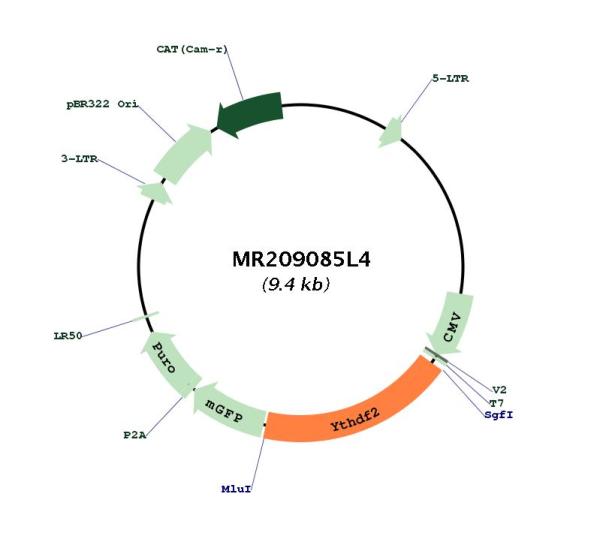Ythdf2 (NM_145393) Mouse Tagged Lenti ORF Clone
CAT#: MR209085L4
- LentiORF®
Lenti ORF clone of Ythdf2 (mGFP-tagged) - Mouse YTH domain family 2 (Ythdf2)
"NM_145393" in other vectors (4)
Interest in protein/lysate? Submit request here!
Specifications
| Product Data | |
| Type | Mouse Tagged ORF Clone |
| Tag | mGFP |
| Symbol | Ythdf2 |
| Synonyms | 9430020E02Rik; HGRG8; NY-REN-2 |
| Vector | pLenti-C-mGFP-P2A-Puro |
| E. coli Selection | Chloramphenicol (34 ug/mL) |
| Mammalian Cell Selection | Puromycin |
| Sequence Data |
The ORF insert of this clone is exactly the same as(MR209085).
|
| Restriction Sites |
SgfI-MluI
Cloning Scheme for this gene
Plasmid Map

|
| ACCN | NM_145393 |
| ORF Size | 1740 bp |
| OTI Disclaimer | The molecular sequence of this clone aligns with the gene accession number as a point of reference only. However, individual transcript sequences of the same gene can differ through naturally occurring variations (e.g. polymorphisms), each with its own valid existence. This clone is substantially in agreement with the reference, but a complete review of all prevailing variants is recommended prior to use. More info |
| OTI Annotation | This clone was engineered to express the complete ORF with an expression tag. Expression varies depending on the nature of the gene. |
| Product Components | The ORF clone is ion-exchange column purified and shipped in a 2D barcoded Matrix tube containing 10ug of transfection-ready, dried plasmid DNA (reconstitute with 100 ul of water). |
| Reconstitution | 1. Centrifuge at 5,000xg for 5min. 2. Carefully open the tube and add 100ul of sterile water to dissolve the DNA. 3. Close the tube and incubate for 10 minutes at room temperature. 4. Briefly vortex the tube and then do a quick spin (less than 5000xg) to concentrate the liquid at the bottom. 5. Store the suspended plasmid at -20°C. The DNA is stable for at least one year from date of shipping when stored at -20°C. |
| Reference Data | |
| RefSeq | NM_145393.2 |
| RefSeq Size | 4078 bp |
| RefSeq ORF | 1740 bp |
| Locus ID | 213541 |
| UniProt ID | Q91YT7 |
| Cytogenetics | 4 D2.3 |
| Gene Summary | Specifically recognizes and binds N6-methyladenosine (m6A)-containing RNAs, and regulates mRNA stability (PubMed:28867294, PubMed:29855337). M6A is a modification present at internal sites of mRNAs and some non-coding RNAs and plays a role in mRNA stability and processing (PubMed:28867294, PubMed:29855337). Acts as a regulator of mRNA stability by promoting degradation of m6A-containing mRNAs via interaction with the CCR4-NOT and ribonuclease P/MRP complexes, depending on the context (PubMed:30065315, PubMed:29855337). M6A-containing mRNAs containing a binding site for RIDA/HRSP12 (5'-GGUUC-3') are preferentially degraded by endoribonucleolytic cleavage: cooperative binding of RIDA/HRSP12 and YTHDF2 to transcripts leads to recruitment of the ribonuclease P/MRP complex (By similarity). Other m6A-containing mRNAs undergo deadenylation via direct interaction between YTHDF2 and CNOT1, leading to recruitment of the CCR4-NOT and subsequent deadenylation of m6A-containing mRNAs (By similarity). Required maternally to regulate oocyte maturation: probably acts by binding to m6A-containing mRNAs, thereby regulating maternal transcript dosage during oocyte maturation, which is essential for the competence of oocytes to sustain early zygotic development (PubMed:28867294). Also involved in hematopoietic stem cells specification by binding to m6A-containing mRNAs, leading to promote their degradation (PubMed:30065315, PubMed:30150673). Also acts as a regulator of neural development by promoting m6A-dependent degradation of neural development-related mRNA targets (PubMed:29855337). Regulates circadian regulation of hepatic lipid metabolism: acts by promoting m6A-dependent degradation of PPARA transcripts (By similarity). Regulates the innate immune response to infection by inhibiting the type I interferon response: acts by binding to m6A-containing IFNB transcripts and promoting their degradation (PubMed:30559377). Also acts as a promoter of cap-independent mRNA translation following heat shock stress: upon stress, relocalizes to the nucleus and specifically binds mRNAs with some m6A methylation mark at their 5'-UTR, protecting demethylation of mRNAs by FTO, thereby promoting cap-independent mRNA translation (By similarity).[UniProtKB/Swiss-Prot Function] |
Documents
| Product Manuals |
| FAQs |
| SDS |
Resources
Other Versions
| SKU | Description | Size | Price |
|---|---|---|---|
| MC200730 | Ythdf2 (untagged) - Mouse YTH domain family 2 (Ythdf2), (10ug) |
USD 540.00 |
|
| MG209085 | Ythdf2 (tGFP-tagged) - Mouse YTH domain family 2 (Ythdf2) |
USD 740.00 |
|
| MR209085 | Ythdf2 (Myc-DDK-tagged) - Mouse YTH domain family 2 (Ythdf2) |
USD 540.00 |
|
| MR209085L3 | Lenti ORF clone of Ythdf2 (Myc-DDK-tagged) - Mouse YTH domain family 2 (Ythdf2) |
USD 840.00 |
{0} Product Review(s)
Be the first one to submit a review






























































































































































































































































 Germany
Germany
 Japan
Japan
 United Kingdom
United Kingdom
 China
China

